The armies of every nation depend on the infantry for the capture and defense of territory, and the infantry is armed with a variety of weapons for this purpose. Given the great number of such weapons in existence, only the more common weapons are shown here.
Firearms (Slugthrowers)
Longarms
B-11 K-Bolt Assault Rifle

A Bragulan soldier with a B-11
For the last five hundred years, the standard Bragulan infantry weapon has been the B-11 K-bolt assault rifle (KAR), a gauss gun that shoots out hypersonic 14mm bragsteel slugs coated in a vegemite derivative that upon ignition transmutes into K-residue, a highly radioactive molecular acid that can eat through power armor and dissolve the living being underneath. While the KAR is an anti-infantry weapon, the size and acidity of its rounds also makes it effective against light vehicles.
The KAR is a very rugged design; many of those used in the Bragulan Legions are decades or even centuries old, often outliving their users and reused by the next batch of troops. The firing rate is adjustable, the standard is 800 rounds per minute though it can be lowered for non-Bragulans. The maximum effective range is 2,000 meters, but for conscripts using simple iron sights, the range is markedly lesser. For elite troops, modular passive-aggressive sensors, active gamma/X-ray arrays, macroperitelescopes, reflex-radiating sights, and other add-ons can be bolted on to significantly increase range and accuracy. The B-11 has a retractable bayonet and can mount an underbarrel microgrenade launcher.
By human standards, the typical KAR is as large as a heavy machine gun, while atypical ones come in several sizes, including more human-portable Cub Scout variants. Older KARs are predominantly composed of stamped bragsteel with lumber handguards and folding stocks, while newer versions replace the lumber with more metal. Typical magazines come in 50-round boxes, 100-round scythes, and 250-round drums. Centuries of continuous production have resulted in an enormous surplus of KARs to sell to the galactic market, making the K-bolter among Bragule's best-selling export products, ubiquitous amongst the revolutionaries, terrorists and criminal syndicates of the galaxy. The B-11 KAR sets the standard for cheap, reliable and mass produceable firepower.
Bu Qiang-98 Battle Rifle and Derivatives
The Bu Qiang 98 is a particularly compact bullpup rifle, with the magazine only one inch in front of the butt plate in order to achieve maximum barrel length. The additional barrel length provides both longer barrel life and greater velocity, as the barrel is stressed less and is able to more efficiently utilize the power supplied. The BQ-98 has an integrated grenade launcher, which feeds from a 5-round detachable box magazine fitted immediately in front of the slugthrower magazine. It fires 25mm grenades and is capable of accepting both lethal and less-lethal ammunition. The pistol grip/trigger module is adjustable to account for differing length of pull requirements of different soldiers. A bipod, flashlight and forward grip are optional accessories. It is most remarkable for its extraordinarily short overall length of 24 inches.
The BQ-98C rifle is similar to the basic BQ-98 but deletes the grenade launcher, saving both weight and volume. It is typically issued to vehicle crews.
The BQ-03 rifle is similar to the BQ-98C but features a lengthened barrel. Various other changes, such as the addition of a bipod, make it suitable for the designated marksman/sniper role. It is also used for ceremonial duties, where the additional length is desired.
Dawkins/Tsien Militech VX-23 Deathcaster Assault Rifle
The Deathcaster Assault Rifle is the standard service rifle of the Commonwealth military, a flexible bullpup rail rifle typically fitted with a 76-round top-mounted horizontal magazine; a 300-round dual-helix magazine is also available, but it is rarely used due to weight and ergonomic concerns. An evolutionary descendant of the Tau rail rifle, it fires 4.5mm explosive armor-piercing rounds at 4.8 km/s, using miniaturized inertial dampeners to handle the weapon's recoil. It has three modes of fire: Semi-automatic, variable burst, and full-auto (850 rounds per minute). Standard features include a HUD linkup scope and fingerprint/identification tag-based anti-theft systems, either passive (the weapon will not function for an unauthorized user, transmit a radio beacon, and announce unauthorized use via audio) or active (in addition to passive anti-theft functions, the weapon will dump a 15,000 volt charge into the hand of an unauthorized user). A reasonably popular export item, it has been compared to the ubiquitous B-11 K-bolter in terms of reliability while weighing less and being easier for the novice to use, if about 2.5 times as expensive to purchase. Other attachments are available, such as smart-form grips for maximum user comfort, underslung flechette and grenade launchers, small scale psi-jammers, and sonic stunners. A more compact variant, the VX-24 Eradicator carbine, exists for urban combat use.
Dawkins/Tsien VX-25 Decimator Battle Rifle
Similar in appearence and mechanisms to the Deathcaster (if upscaled), the VX-25 Decimator is designed for use by heavy posthuman soldiers to effectively combat opponents using power armor. It fires 10mm ammunition at 6.5 km/s at a rate of 850 rounds per minute. It can accept a variety of additional modules such as grenade launchers. It is fed by a more conventional bullpup vertical feed system which can typically accept a 40 round box or 120 round drum magazine, though it can also be modified to use a belt feed. Its effective range is rated at around 5,000 meters in the steady mechanical grip of a Cougar Combat Form on single shot. Due to its weight (14.3 kilograms) and its recoil even with considerable inertial dampening, it is in no way practical for regular soldiers to wield it as a rifle. That said, a specialized variant is used as a machine gun.
M18 Gauss Submachine Gun
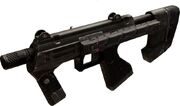
An M18 gauss SMG
The M18 (formally Gauss Submachine Gun, Caliber 4.6 mm, M18) is a relatively common personal defense weapon issued to the SOS Imperial Guard and Marine Corps. Manufactured by Morita as part of its line of gauss weaponry, it is a bullpup weapon that fires 4.6mm high explosive armor-piercing slugs at 4.2 km/s, using a system of miniaturized inertial dampeners in order to help control recoil; even with the dampeners, though, its recoil on full-auto can be quite considerable for an inexperienced user. The weapon has a four-position (safe, semi-automatic, burst, and full-automatic) trigger group with an ambidextrous selector; burst fire can be set from 2 to 6 rounds, while full-auto fire is adjustable by the user (minimum is 600 rpm, factory-rated maximum is 900 rpm, default is 750 rpm). The standard magazine issued for the M18 is a 72-round horizontal box mounted on the left side of the weapon. It is most notable for its highly compact size (47 cm long with stock retracted and 63 cm with stock fully extended), which makes it popular with vehicle crews and special operations forces. The deployable vertical foregrip further aids in the weapon's maneuverability, making it easier to point and aim.
M66 Gauss Rifle

An M66 gauss rifle
The M66 (formally Gauss Rifle, Caliber 8.6 mm, M66) is a common assault rifle issued to the SOS Imperial Guard and Marine Corps. It is a bullpup weapon manufactured by Morita Firearms and fires 8.6mm high explosive armor-piercing rounds at 5.6 km/s, using a system of miniaturized inertial dampeners in order to help control recoil. The weapon has a four-position (safe, semi-automatic, burst, and full-automatic) trigger group with an ambidextrous selector; burst fire can be set from 2 to 6 rounds, while full-auto fire is adjustable by the user (minimum is 600 rpm, factory-rated maximum is 800 rpm, default is 700 rpm). The standard magazine issued for the M66 is a 36-round box, though a 72-round quad-column "casket" and 108-round drum are also available. Its maximum effective range is 2,000 meters, which can easily be accomplished with the integrated optics suite. The M66 is compatible with a wide range of accessories and attachments, such as the M412 underslung grenade launcher, a modified version of the M74 shotgun, and even a bayonet.
The M66 is a popular slugthrower on the galactic arms market, comparable to the B-11 K-bolter across a variety of metrics and generally viewed as an excellent (if relatively more expensive) alternative to the ubiquitous Bragulan weapon. Compared to the Dawkins/Tsien Militech VX-23, the M66 has superior range, superior penetration and stopping power per individual round, and is far less expensive, though it is a heavier weapon that lacks the VX-23's anti-theft mechanism and has inferior ammunition capacity when fitted with the standard 36-round box.
M74 Combat Shotgun

The M74 shotgun
The M74 (formally Shotgun, Caliber 20 mm, M74) is the standard combat shotgun of the SOS Imperial Guard; despite the fact that the SOS Imperial Marine Corps have adopted the M101 as their standard shotgun, considerable numbers of M74s still remain in their inventories. Built by Seburo, it is a dual-mode (semi-automatic and pump-action) shotgun that fires a variety of 20mm shells and slugs; the standard round is a shot shell using quadruple-ought (0000) depleted uranium buckshot, though other types of ammunition are available. The weapon feeds from an integrated six-round tube magazine and is capable of accepting a variety of accessories, such as close-range optics and a bayonet. A cut-down and highly modified variant is used as an underslung attachment on various SOS Imperial Armed Forces rifles.
M101 Combat Shotgun
The M101 (formally Shotgun, Caliber 20 mm, M101) is a semi-automatic combat shotgun used almost exclusively by the SOS Imperial Marine Corps, though some have also been issued to the more elite units of the SOS Imperial Guard. Built by Seburo, it is largely a simplified version of the M74, the most significant difference being that the M101 is semi-automatic only.
M110 Heavy Gauss Rifle
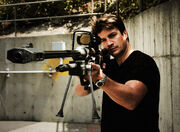
Captain John Tamrin with an M110 gauss rifle
The M110 (formally Gauss Rifle, Caliber 14 mm, M110) is the standard anti-personnel sniper rifle issued to the SOS Imperial Guard and Marine Corps. Manufactured by Morita as part of its line of gauss weaponry, it employs a "conventional" layout (magazine in front of the trigger group) and fires a variety of 14mm slugs; the standard military round is a high explosive armor-piercing incendiary slug, though it can also accept other types of ammunition, such as regular high explosive armor-piercing, hypervelocity kinetic penetrator (trinium, tungsten carbide, or depleted uranium), solid metal, and even standard K-bolts taken from the B-11 K-bolter. While the weapon is equipped with inertial dampeners, its recoil can still be quite considerable, especially when fired from an unsupported position without power assistance. It has a two-position (safe, semi-automatic) trigger group with an ambidextrous selector. The weapon typically feeds from a 5-round detachable box magazine, though 7- and 10-round extended magazines are also available. Other standard features include a bipod and a highly sophisticated targeting suite. While the M110's factory-stated maximum effective range is 5,000 meters, it has been known to exceed that figure in the field.
Maibatsu USAS-3112
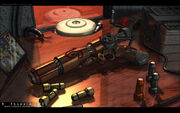
Maibatsu USAS-3112
The United Solarian Automatic Shotgun, Model 3112 is a fully automatic shotgun designed by the fledgling Maibatsu megacorp during the First Bragulan War. Designed to be used during boarding actions where Solarian marines were expected to go up to Bragulan naval infantry in close quarters combat, the overriding concern during the design phase of the Model 3112 was stopping power. This is why Maibatsu designed it around a 20mm depleted uranium buckshot cartridge capable of putting down a lightly armored Bragulan with a single shot. Passingly familiar with Bragulan rushing tactics, Maibatsu then made the 3112 capable of fully automatic fire, enabling the weapon to fill a corridor, hab-space, or cargo bay with a storm of hypervelocity shrapnel in a matter of microseconds. The USAS-3112 was a smash hit amongst Marine raiders and has long since proliferated to all kinds of Wild Space outfits who love the weapon for its rugged simplicity and unconscionable overkill. The Maibatsu USAS-3112 accepts detachable 20-round box magazines or 100-round drum magazines. Its basic design has not changed in several hundred years, and it is still marketed with the same slogan: "Makes gutting Bragulans easy!"
RA-10 Assault Rifle
The predecessor to the RA-12, the RA-10 resembles the RA-12 in aesthetics and general performance, though it is slightly inferior across a variety of metrics. The bulk of remaining RA-10s in the Humanist Union have been relegated to reserves, far-flung Civil Defense and police units, endorsed militias, and to the heavily-regulated civilian market; new-build RA-10s are generally produced for export purposes. A widely-dispersed design popular due to its low cost and relative lack of technical complication, it can be found in the hands of socialist guerillas galaxy-wide, to whom the Union is willing to provide weapons at a bargain with fairly few questions asked.
RA-12 Assault Rifle
The standard-issue military rifle in the Humanist Union, the RA-12 is a rugged, high-power assault rifle known mostly for its stopping power and durability. The RA-12's primary disadvantage is in its recoil, which is considerable for an inexperienced user without powered assistance. Easy and cheap to manufacture, the RA-12 can function long after other personal infantry weapons have failed under extreme combat conditions. The RA-12 serves as a base for several other designs, including the RAb-12 bullpup rifle and the RAm-12 SAW.
RAE-5 Assault Rifle
The RAE-5 is an automatic mass driver designed for use by the Humanist Union's elite Special Operations units. Compared to the RA-12, the RAE-5 is more complicated and expensive, but much more lethal. Its low recoil compensates for its firing rate. Equipped with a more complicated version of the integrated targeting gear found in the standard RA-12 and the older RA-10, the RAE-5 is lethally accurate even at extreme ranges. Unfortunately, the RAE-5 is heavy and unwieldly, making it impractical as a main rifle for light or no-assist infantry troopers.
Stitchkyn APS

A Stitchkyn APS
Colloquially known as the "Bragulan Needler," the Avtoneedelchyeskiyi Pyistolyet Stitchkyna is a personal defense weapon noted for its high rate of fire and compact size, roughly analogous to modern submachine guns. It rapid-fires monomolecular-edged trinium needles designed to shear through unprotected targets and perforate light body armor; explosive armor-piercing flechettes are also available for better-protected targets. The weapon emits a sharp hissing sound when fired, which can be easily suppressed. Silenced Stitchkyns are a choice weapon for Bragulan special forces in dealing with soft targets, preferring the weapon's simplicity, extremely low recoil, and small size. The Stitchkyn comes with a shoulder stock and has three firing settings: Single shot, twelve-round burst, and full automatic.
SVB Designated Marksbear Rifle

Bragunov schematic.
The Snaypyeriskaya Vyintkovka Bragunova is designed for long range precision fire. The SVB is issued to a squad's designated sharpshooters and can be used for long-distance disruption and suppressive fire, and in eliminating valuable targets such as enemy key personnel like officers, comms operators, exposed tank commanders, enemy marksmen and snipers, heavy weapons teams, anti-tank warfare teams, surveillance drones, etc.
The Bragunov is a gauss rifle that can fire 3.5 centimeter rounds at a standard range of five kilometers, jet-assisted projectiles can extend this range considerably. It can use a variety of rounds, from the usual high explosive armor piercing darts and repleted uranium penetrators to non-luminescent K-bolts and target-seeking projectiles. Specialist rounds for elite Storm Snipers include exotic Karlack toxin needles, bottled bioplasma and hi-rad micronukes. The Bragunov uses a Braglaleika macro-monocular optical sight capable of extreme magnification, with image intensification and EM spectrum-filtered multiple vision modes. The system is entirely passive, as standard radiological aggressive-sensors can give away the shooter's location, something undesirable for concealed snipers.
Sidearms
Bragnum Service Revolver
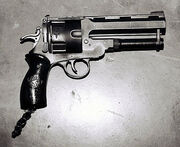
A Bragnum service revolver
For eight hundred years, the Bragnum Service Revolver has been the standard sidearm of the Bragulan armed forces, used by arbitrators to dispense the Imperator's law, commissars to administer field executions, and officers to lead trench charges. Conscripts are not issued service revolvers, unlike professional volunteers and Shock Troops. The Bragnum is a break-open design with a six-round cylinder and a magnetically rifled bragsteel barrel originally chambered for 30mm rounds, though with the advent of modern armor the caliber has been upgraded to 44mm for superior stopping power. By human standards, the Bragnum is practically a grenade launcher, and the recoil from the explosively propelled rounds is enough to break an unaugmented human's wrists. The standard round is the 44mm focused high explosive; other common rounds include armor-piercing sabots, uranium buckshot, flechettes, K-bolts, and good old-fashioned full bragsteel jacket.
Colt M2411 and Derivatives

The Duke of Death, Auriga Bob, the most notorious user of the Colt M2411
The Colt M2411 is a direct evolutionary descendant of the truly ancient M1911 and was built by Colt to commemorate one of its most popular designs. The company went through great pains to make the 2411 the finest weapon in the galaxy, with accuracy and stopping power that would make it even better than the handheld energy pistols of its time. Even though the original M2411 is largely considered an antique in this day and age, its accuracy and stopping power are still quite considerable, met or exceeded only by high-powered sidearms such as the M17, Morita Model 27, SQ-16, and M11 Diamondback.
Just as it was with the original M1911, numerous manufacturers have made their own copies of the M2411. The quality of M2411 copies varies widely, ranging from highly unreliable "garage" copies made by cottage gunsmiths in impoverished places like Cananaan and the Feelipeens to factory-produced reproductions by companies like DeBarros, Maibatsu, Morita, and Seburo that are as good as the original. Copies are considerably more numerous than original M2411s, which are considered highly valuable collectors' items.
Dawkins/Tsien Militech DS-37 Viper Sidearm
The DS-37 Viper is the main sidearm of the Commonwealth military. Designed to provide an effective fallback weapon in case of attack by either large numbers of poorly equipped enemies or more durable ones, the DS-37 sports a modular design. The basic weapon fires regular 6.5mm explosive AP rounds at 2.5 km/s and feeds from a 23-round magazine; it can accept an underslung "magnum" attachment that fires 13.5mm rounds at 3.7 km/s and feeds from a separate 7-round magazine. This attachment can be loaded with a variety of ammunition, including grenade, armor-piercing, and incinerite-based incendiary; while Commonwealth military models are limited to official-issue ammo, various third-party firms have developed a variety of aftermarket rounds for export models. , The Magnum attachment (unlike the basic weapon) is set to have a rate of fire of 30 rpm for reasons of acuracy and controlability. Minaturized inertial dampeners reduce the recoil of each shot for both components. Both components have a maximum range of about 100 meters. In its standard configuration with the magnum attachment, the DS-37 weighs 1.5 kg; without the magnum attachment, it weighs only 1.05 kg. Like the VX-23 Deathcaster, it is equipped with either an active or a passive anti-theft device and can accept a number of other modifications. The DS-37 is very well-regarded for its flexibility and has become relatively popular on the export market.
M17 Gauss Pistol
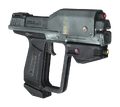
An M17 gauss pistol
The M17 (formally Gauss Pistol, Caliber 11.5 mm, M17) is the standard sidearm issued to the SOS Imperial Guard and Marine Corps. It is a semi-automatic pistol manufactured by Morita Firearms that fires a variety of 11.5mm slugs at 3.3 km/s; the standard military and law enforcement round is a high explosive armor-piercing slug, though it can also fire solid metal, high explosive armor-piercing incendiary, hypervelocity kinetic penetrator (trinium, tungsten carbide, or depleted uranium), and fragmentation rounds. Miniaturized inertial dampeners help reduce the pistol's recoil. It is typically issued with a 12-round box magazine, though 16- and 20-round extended magazines are also available for military and law enforcement users. The M17 can also be fitted with optics, a laser aiming module, a detachable stock, and an extended barrel.
The M17 is one of the most popular pistols on the galactic arms market, with sales figures comparable to those of the Solarian M11 Diamondback. Koprulu Zone users in particular like to refer to it as the "Baby Bragnum," as its capabilities are quite similar to a downsized version of the Bragulan revolver; in any case, it is certainly more user-friendly than the full-size Bragnum by human standards.
Morita Firearms Model 27 Habu
The Morita Firearms Model 27 Habu is a product of a rare joint venture between the arms industries of the Holy Empire of Haruhi Suzumiya and the Nova Atlantean Commonwealth.
While the original Dawkins/Tsien Militech DS-37 Viper was well received on the export market due to its flexible design, much of its draw came from the "magnum" attachment that came standard with the weapon; many customers were disappointed to find out that Dawkins/Tsien did not offer the magnum as a stand-alone weapon. Morita Firearms, one of several firms that produced 13.5mm ammunition for export users of the DS-37, chose to capitalize on this golden opportunity and approached Dawkins/Tsien to design a stand-alone weapon based on the Nova Atlantean 13.5mm magnum round. The resulting product, the Model 27 Habu, is heavily based on Morita's tried and proven M17 gauss pistol design, to the point where many parts are interchangeable between the two weapons.
The Model 27 fires the 13.5mm round at 3.9 km/s and accepts all Commonwealth milspec and third-party civilian ammunition (including Morita's own line of 13.5mm ammo). It is designed to feed from the DS-37 magnum's standard 7-round box magazine, though it can also accept a 9-round extended magazine; the extended magazine is also compatible with the original DS-37 magnum. Like the M17, the Model 27 can be fitted with optics, a laser aiming module, a detachable stock, and an extended barrel; models produced for the Nova Atlantean market also feature a dual-mode passive/aggressive anti-theft system.
Dawkins/Tsien Militech also produces the Model 27, marketing it as the DS-38 Bushmaster Heavy Sidearm. While the Model 27/DS-38 has not been adopted by either the Commonwealth military or the SOS Imperial Armed Forces, it is still a highly popular item on the galactic arms market; Koprulu Zone users call it the "3B" (Big Baby Bragnum) due to its increased firepower compared to the original M17.
Shou Qiang-16 Service Pistol
The Shou Qiang-16 pistol is relatively unique amongst contemporary service slugthrowers in that the projectile is stripped off the magazine backwards; that is, the initial motion of the projectile is to the rear before being pushed forward into the barrel. This arrangement maximizes barrel length, giving a full inch longer of a barrel, resulting in reduced stress on the gravitic accelerator and increased barrel life. The SQ-16 can have a collapsible stock attached, allowing full-auto fire and increased stability. Laser sights, as well as video remote and reflex sights, can be attached for additional functionality. Pistols are commonly issued to rear area troops, vehicle crews, and machinegunners. It utilizes the same ammunition as the standard BQ-98 rifle, but at a reduced velocity due to the decreased barrel length and for controllability purposes. It generates approximately 50% of the BQ-98's velocity without a stock and 75% of the BQ-98's velocity with stock attached and extended.
Energy-based Small Arms
AB-185 Assault Blaster

The AB-185 Assault Blaster
The AB-185 Assault Blaster is to the Centrality what the K-Bolter is to the Bragulans. While a bit less ubiquitous than the infamous Bragulan slugthrower, the AB is still the most common energy weapon in existence, with hundreds of billions estimated to currently be in circulation. The first AB model entered service with the Central Army in 3027, and since then has seen many upgrades to its design. The basic variant of the weapon has three standard fire settings (automatic, semi-auto, and pulse-fire) and can accept a variety of attachments and other accessories. The AB's firepower is variable, has a stun feature, a very large ammo capacity (the average gas cartridge has a total of 600 shots, depending on the firepower setting), and has a very high rate of fire for a weapon of its class.
B-11 Chamarran Beam Rifle

Two Chamarran soldiers with a B-11 beam rifle and three smart mines
The B-11 is both the standard infantry weapon of the Chamarran armed forces and a weapon widely used by mercenaries and other fringe groups in and around the Hierarchy's borders. The firepower of the beam rifle, combined with the protective abilities of Chamarran personal forcefields, places the user on par with most standard power armor packages. The beam rifle's strength is largely due to its high-powered double-shot firing mode, which discharges the twin emitters simultaneously and packs enough of a punch to pierce most power armor and even some light vehicles. For lighter anti-personnel use, the weapon can be switched to a faster cycling alternating fire mode, where its blasts prove as adept at shearing through flesh as they are at piercing armor.
While an undoubtedly powerful personal weapon, the B-11 beam rifle does have some flaws. Its primary flaw is that it is incapable of truly rapid fire on par with other energy-based assault weapons like the AB-185, M48, and M116; its power management systems are highly simplified compared to other energy weapons, and its power requirements are such that it consumes power cartridges at an exceptional rate.
Dawkins/Tsien Militech DX-03 Lightning Shield Disruption Rifle
The rise of personal shields has been of some concern to the Commonwealth's military, and projects were approved to devise effective man-portable anti-shield weapons in the 3360s. While specialized shield-penetrating ammunition for weapons such as the Deathcaster and Viper has had some success, one of the most effective produced under these programs was the purpose-built DX-03 Lighting Shield Disruption Rifle. An anomaly among Nova Atlantean small arms among a wide variety of rail and gauss weapons, the DX-03 is a charged particle weapon, the beam of which is on average three to five times as effective per watt against personal level shields than most other energy or projectile weapons. However, against physical armor, it is very much lacking in terms of penetration, and all but the lightest vehicle-strength shielding is more than enough to negate its effects. As such, it is generally only issued in instances in which large numbers of shielded individuals are anticipated. It has a variable power setting and uses a power cell with 50-300 shots, depending on the level of output. It has the anti-theft measures that are typical to a Nova Atlantean rifle. While not a big ticket item like the Deathcaster or the Viper, it has found its niche on the galactic arms market.
M11 Diamondback High Standard Plasma Pistol
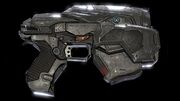
An M11 Diamondback
The M11 Diamondback High Standard Plasma Pistol is a semi-automatic plasma pistol that fires 8mm bolts in the 40 watt range. The Diamondback is the standard sidearm for USMC troops. Highly compact, it is loaded with self-cooling cartridges each containing 40 rounds, and is equipped with an integral flash suppressor, a LED ammo counter and an auto-targeting module with built-in IFF function. A best-selling DeBarros product, the M11 Diamondback is colloquially referred to as "an M116 in a can" due to the handgun featuring the same stopping power in a much smaller and lighter frame. Marines, mercenaries, and private citizens alike appreciate the lightweight handgun's penetrating power, accuracy, and balance.
M36 Plasma Pistol

An M36 plasma pistol
The M36 plasma pistol is one of the more unusual weapons issued to the SOS Imperial Guard and Marine Corps. Manufactured by Seburo Firearms, its general design is markedly different from most of its other products, as it was initially adapted from a similar sidearm used by the Kroot, Vespids, and other Tau auxiliaries during the Imperium-Tau War; the weapon has seen numerous progressive refinements and improvements over the centuries in order to keep it competitive with other designs such as the M11 Diamondback.
The M36 in its current form is a highly compact semi-automatic plasma pistol with a three-position (safe, semi-automatic, overcharge) trigger group with an ambidextrous selector. In its standard semi-auto fire setting, it fires 6.8mm bolts in the 32 watt range. In the overcharge setting, it fires a 12.7mm bolt in the 48 watt range, though it produces truly large amounts of waste heat per individual shot and requires a delay in order to cool off, which lowers its effective firing rate. A standard-capacity magazine holds enough power for 100 shots on semi-auto or 10 shots on overcharge mode. The weapon is fitted with an LED ammo counter/temperature gauge; military models are compatible with an auto-targeting module with integrated IFF.
Despite its decidedly unorthodox design, the M36 is still a relatively popular weapon on the galactic arms market. Koprulu Zone users in particular refer to it as the "Baby Diamondback" due to its small size and the "Canned PIG" due to the surprisingly large punch it packs when fired in overcharge mode; a favorite tactic against heavily-armored foes is to dual-wield the M36 and M11, using the M36's overcharge mode to blast a hole in the target's defenses before following up with the M11.
M48 Phased Plasma Assault Rifle
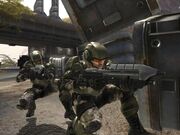
Two SOS Imperial Guardsmen armed with M48 pulse rifles
The M48 (more formally Phased Plasma Pulse Rifle, Caliber 8.6 mm, M48) is the most common rifle issued to the SOS Imperial Guard and Marine Corps. It is a bullpup weapon manufactured by Seburo Firearms and fires 8.6mm darts of superheated hydrogen plasma in the 32.5-37.5 watt range (adjustable by the user; default power setting is 35 watts) that produces cauterizing and vaporizing effects comparable to those of the M116. The M48 has a four-position (safe, semi-automatic, burst, and full-automatic) trigger group with an ambidextrous selector; burst fire can be set from 2 to 6 shots, while full-automatic rate of fire is dependent on power setting (1,050 rpm at 32.5 watts, 900 rpm at 35 watts, or 750 rpm at 37.5 watts). Ammunition capacity varies depending on power setting; a standard-capacity magazine carries enough power for 600 shots at 32.5 watts, 450 shots at 35 watts, or 300 shots at 37.5 watts. Maximum effective range of the M48 is also dependent on power setting (1,200 meters at 32.5 watts, 1,350 meters at 35 watts, or 1,500 meters at 37.5 watts). The M48's interfacing electronics and integrated targeting suite have been upgraded steadily over the years; the latest variant in service, the M48A4, has targeting capabilities comparable to those of the latest models of the M116. The M48 is also compatible with a wide range of attachments and accessories; the M412 underslung grenade launcher and a modified version of the M74 shotgun are the most common attachments seen on rifles in Haruhiist service.
M116 Phased Plasma Assault Rifle

An M116 being fired by marine in light armor
The M116 (more formally Phased Plasma Pulse Rifle, Caliber 10 mm, M116) is the primary assault rifle of the USMC. It is a bullpup weapon manufactured by DeBarros General Products' Planetary Warfare Division and rapid-fires 10mm darts of superheated hydrogen plasma in the 40 watt range that can produce massive cauterizing and vaporizing effects when the bolt impacts at high velocity. Maximum effective range of the M116 is 1,500 meters. The M116 is designed for use by combat armored troops and thus heavy, and the interfacing electronics and built-in passive electro-optic, broad-spectrum imaging, motion-tracking and laser rangefinding module make that rifles of the M116 family are more versatile, more powerful, but also more expensive than many available alternatives.
M281 Phased Plasma Battle Rifle

An M281 pulse rifle
The M281 (formally Phased Plasma Pulse Rifle, Caliber 11.5 mm, M281) was once the primary service rifle of SOS Imperial Guard and Marine Corps before it was officially replaced by the M48; however, large numbers of M281s still remain in SOS Imperial Armed Forces armories and are used for specialty roles in front line service. Manufactured by Seburo Firearms, it is a bullpup weapon that fires 11.5mm bolts in the 40 watt range. The M281 has a four-position (safe, semi-automatic, burst, and full-automatic) trigger group with an ambidextrous selector; burst fire can be set from 2 to 6 shots, while full-automatic rate of fire is adjustable by the user (minimum is 600 rpm, factory-rated maximum is 800 rpm, default is 700 rpm). Maximum effective range of the M281 is 1,600 meters. The M281's interfacing electronics and integrated targeting suite have been upgraded steadily over the years; M281s still in SOS Imperial Armed Forces service have targeting capabilities comparable to those of the latest models of the M116. The M281 is also compatible with a wide range of attachments and accessories; the M412 underslung grenade launcher and a modified version of the M74 shotgun are the most common attachments seen on rifles remaining in Haruhiist service.
The M281 is particularly notable for its cosmetic resemblance to the M66 gauss rifle. At a distance, the M281 can most easily be distinguished from the M66 by its lack of carrying handle.
SIG Saucer P22Z Psi-Gun

A CEID agent with a P22Z
The P22Z is a unique weapon made by Selindil Iiirthuu Gesellschaft Saucer, an Apexai arms manufacturer from Zedath-Kalesh. It is a hyper-compact autolaser with an exotic (and very classified) power unit and an intricate microcryosystem that current Solarian technology has been so far been unable to replicate. This unusually small package is capable of matching the devastating outputs of much larger phased plasma weapons and far surpasses them with its unerring accuracy, due to an Apexai mind-interface system.
Apexai crystals that harmonize with the user's thoughts are positioned in key parts of the P22Z. The user, almost always a CEID agent, is given the requisite psionic weapons training necessary to wield the P22Z effectively. Training involves connecting the mind to the Apexai crystals, allowing the weapon itself to "see" what the user sees, locking on to the targets the user wishes to strike with a thought. For radically increased accuracy, CEID agents can focus their minds to perceive in the sixth and seventh senses rather than the mere five, in a way similar to the weapon's original Apexai makers. The increased psionic harmony between user and weapon transforms the P22Z into more than just an extension of the user's body, making it into a true extension of his/her mind. With the P22Z's ability to fire off-axis in either rapid-fire pulses or in scything beams, it doesn't even have to be pointed directly at the target to kill.
An even deadlier P22Z variant exists for more potent CEID psions. Refined psionic crystals and a psycho-conducive polymetal grip allow the user to not only mentally aim the P22Z, but also channel psionic energy into it to dramatically increase the damage done by the autolaser or even refract the Apexai crystals to send the beams curving around obstacles to strike the enemy. The intense mental effort required is something the vast majority of psions are incapable of doing, which is why this enhanced P22Z is only issued to CEID's psion elites. The P22Z can be slowly recharged by the user's psychoplasm, a less intense process easier for ordinary psions.
In the past, psionic weapons much like the P22Z were the standard arms of the Apexai. Only a few of these weapons exist today, most made by SIG Saucer. The P22Z is made almost exclusively for CEID, though a few have fallen into the hands of extra-governmental entities like private Apexai citizens, very affluent psions, Cerberus Syndicate operatives, and other less savory characters. The most notable non-CEID user is Empress Haruhi Suzumiya, who owns a highly customized P22Z built by SIG Saucer to her own personal specifications.
Infantry Support Weapons
B-35 Precision Cannon
The B-35 Precision Cannon is a "smart" gun fielded by professional units and special forces in the Bragulan military. It is a computer-aimed, video-targeted automatic weapon attached to servohydraulic armor by a brace and a gyro-stabilized support arm - a revolver cannon mounted on sort of a steadicam that kills. The gyro-support arm is controlled by a computer linked to passive-aggressive sensors, a smart system that not only directs rounds to their targets but also detects structural vulnerabilities such as a building's support pillars or soft spots in enemy armor. When switched to aggressive-aggressive mode, the gamma/x-ray array can bathe targets in lethal amounts of radiation, a feature often used by off-duty Bragtroops to cook flocks of birds; in urban combat, it can be used to see through walls before shooting through them. The weapon has a range of nearly 4 miles (6.4 kilometers) and can fire K-bolts, repleted uranium spikes, bottled Karlack bioplasma, vegemite buckshot, HESH (High Explosive Smash Head), monomolecular fragmentation rounds, thermobarics, micro-grenades and more.
B-NET K-cannon
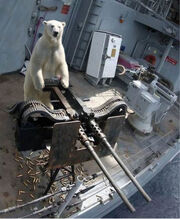
A navy trooper with a twin-linked B-NET
The Bragulan B-NET K-cannon is a heavy infantry weapon for anti-personnel and anti-vehicle use. It fires 20mm K-bolts at 1000 rpm, with an effective range of 3.6 to 4 kilometers. If the B-11 rifle is as large as a human machine gun, then the B-NET is as big as a vehicle-mounted chaingun. B-NETs are usually issued to paired conscripts, one to lug the weapon and another to haul a drum full of ammo belts. Better-equipped troops forego this and can carry the guns and ammo individually with servohydraulics to bear the weight and aid in targeting. Vehicle-mounted B-NETs are usually twin-linked.
The B-NET K-cannon has far greater firepower than the B-11; it is faster-firing and shoots larger slugs at higher speeds, giving it excellent armor-piercing capability. Its rounds are cored with repleted uranium, a self-sharpening and pyrophoric substance; upon impacting a vehicle, the K-bolt not only spews acid residues but also radioactive particulates that catch fire, ignite ammunition and fuel, kill the crew, and possibly cause the vehicle to explode.
Banyong Liudan Qiang-01 Automatic Grenade Launcher
The Banyong Liudan Qiang-01 is a 25mm squad grenade launcher. It can be either belt-fed or magazine-fed, depending on mounting. For hand-held use, it is equipped with a stock and pistol grip and feeds from a 10-round magazine; it can also accept BQ-98 grenade magazines, and vice versa. A 30-round helical magazine can also be utilized, which is not compatible with the BQ-98. The BLQ-01 can also be fitted directly onto power armor, or mounted onto a tripod or pintle mount and fitted with spade grips. When belt-fed, a multi-feed option is available to allow selection of ammunition before firing, such as pinch warheads, conventional HE, armor-piercing, incendiary, or shotgun rounds.
Big Borscht HIM
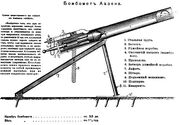
Borscht instruction manual.
Named for its propensity for turning enemies into soup, the Big Borscht Heavy Infantry Mortar is a telescreen-guided breech-loaded 320mm bear-portable artillery piece composed of a big bore magnetic accelerator tubule, a bragsteel base plate, and a hydraulic bipod. It can launch a wide variety of munitions at targets as far away as 9km. Rocket boosters and extended barrels for vehicle-mounted models can increase this range significantly. Typircal rounds include HE, HEAT, HEAP, HEAD, HESH, cluster munitions, thermobarics, incendiary isotopes, biochemical weapons, signalling or laser/energy refracting smoke, vegemite chaff, radium flares, micro-nukes, neutron bombs, fragmentary "dirty bombs," and EMP warheads. To defeat point-defenses and CIWS, Borscht batteries can saturate areas with laser/energy refracting smoke and vegemite chaff before lobbing depressed angle rocket-assisted warheads. Due to its size, the mortar and its rounds are carried by whole fireteams.
M78 Phased Plasma Infantry Gun
The M78 PIG (Plasma Infantry Gun, formally Phased Plasma Assault Gun, Caliber 13 mm, M78, Flexible) is a (barely) man-portable weapon designed to be effective against heavy armor and power-armored infantry alike. Manufactured by DeBarros as part of a range of plasma assault weapons, it fires 13mm darts of plasma in the 50 watt range. The fast-discharge system powering the gun has a dialable firing cycle with a maximum rate of fire of 850 bolts per minute. In order to keep the gun from melting during sustained fire it is fitted with an advanced cryo-system. The penetrating power of the system is considerable, and it is claimed to be able to breach the flank armor of a Chornyb Urban Pacifier at 4,000 m. Although one of the oldest active weapons in the arsenal of the USMC, the marines continue to like the M78 for its penetrating power and extremely high rate of fire, the combination of which means it is utter overkill against most of the targets typically engaged with it.
M97 Stonecleaver Infantry Grenade Launcher
The M97 Stonecleaver (formally Grenade Launcher, Caliber 60 mm, M97) is a heavy automatic grenade launcher with an effective range of 5 km, developed and manufactured by Solaris Advanced Weapons Corporation. The M97 was intended to significantly increase a small squad's firepower and fires a wide variety of programmable smart grenades from two dual-mounted 25-round box magazines. With the press of a button, the wielder can switch between magazines, allowing rapid shifting between different kinds of munitions. At 25 kg, the M97 can be carried and fired only by power-armored troops; the Stonecleaver is fitted with a ballistic computer that feeds targeting data directly into a combat suit's VHUD. The M97 suffers somewhat from being over-engineered; amongst marines the M97 is known as fussy, requiring careful maintenance to prevent loss of reliability. Like most Solarian weapons systems, the M97's numerical designation follows the unofficial USMC/SOS Classification System.
SAWco has developed a plethora of grenade types for the Stonecleaver: HE, HE Target Seeking, HEAT, High Explosive Flechette, Enhanced HE, HE Breaching, Concussion, Tangler Monowire, EMP, AMAG, Close Combat Flechette, Prism Smoke, Biotech Motion Restraint, Scrambler, Programmable Nanostat Swarm, and Gauss Field.
M358 GP Gauss Machine Gun
The M358 general purpose gauss machine gun (formally Gauss Machine Gun, Caliber 8.6 mm, M358) is the standard support weapon of the the SOS Imperial Guard and Marine Corps. Manufactured by Morita as part of its line of gauss weaponry, it fires 8.6mm high explosive armor-piercing incendiary slugs at 6 km/s at a maximum rate of fire of 900 rpm; even though it is built with inertial dampeners in order to control recoil, it can still be considerable for an inexperienced user without powered assistance. Its maximum effective range is 4,000 meters with optics. Standard SOS Imperial Armed Forces doctrine states that the M358 is to be issued to teams of two soldiers, one to operate the weapon and the other to carry spare ammunition and other supplies; however, in practice, the M358 is often operated and maintained by a single soldier.
M412 Grenade Launcher
The M412 (formally Grenade Launcher, Caliber 40 mm, M412) is an underslung single-shot grenade launcher manufactured by Seburo Firearms. While it is designed to be attached to the M48, M66, and M281 rifles, the M412 can also be used as a stand-alone weapon simply by attaching a buttstock; Seburo also manufactures adaptors to fit the M412 to a wide variety of other weapons, such as the AB-185, M116, and VX-23. It is compatible with a wide range of lethal and less-lethal ammunition.
Nuclear Flamethrowers
Nuclear flamethrowers use incendiary isotopes to incinerate, irradiate and immolate those deserving Byzonic burnination and are typically used in urban pacification and close quarters combat. There are three general kinds fielded by Bragulan troops, differentiated by the fuel they use. Unleaded-plutonium fossil fuel flamers use the distilled fuels of Bragulan ground vehicles minus releading, as plutonium-spiked diesel is releaded to decrease the radioactivity of its fumes, and have the advantage of readily available fuel sources as all one needs is a distiller and easy access to the motor pool, while the disadvantage is that it is practically just napalm mixed with a dirty radiation bomb. Double V flamers use vegemite-saturated vespene gas for a similar but more intense effect, as vegemite is significantly more radioactive than plutonium-spiked diesel and vespene burns at plasmatic temperatures, while the disadvantage is that vegemite-vespene is not as accessible. Liquid thorium flamers are almost only used by Bragulan naval infantry who use weaponized coolant hoses in boarding actions.
Tongyong Ji Qiang-95 GPMG
The Tongyong Ji Qiang-95 GPMG is the standard support weapon of the Lujun. A belt-fed weapon, it fires the same ammunition and uses the same sight module as the BQ-98 rifle in order to simplify training. The TJQ-95 can be fitted directly to power armor, mounted on a tripod or pintle mount with spade grips, or carried with a pistol grip and bipod.
VX-30 Vindicator Century Level Weapon
The VX-30 is a dual-purpose linear accelerator weapon able to reconfigure itself to serve two distinct purposes. The first mode is that of a standard anti-personnel heavy machine gun, firing 10mm rounds at 6.5 km/s at a rate of 1,000 rpm. The secondary mode has the accelerator array widen, allowing it to fire 30mm AP rounds at 15 km/s, at a mechanically restricted rate of 25 rpm semi-automatically. Its secondary fire mode makes it very useful against power-armored soldiers and light vehicles including many APCs, although the weapon masses some 36 kilograms, making it hard to move by hand. Typically it is carried by specialized teams or mounted on light vehicles such as Iceskinks.
Anti-Vehicle Weapons
Amaterasu Armaments SRLg-10 Zweihander Rocket Launcher
Designed by Yamato-based Amaterasu Armaments, the Zweihander is the main infantry rocket launcher used by the Commonwealth military. Firing 10.5cm rockets, the system has several unique features. While it can be fired like a conventional rocket launcher, it is normally mounted on a shoulder-mounted assisted platform controllable by either a joystick or a direct cybernetic interface. The launcher also uses a low-power gauss accelerator to jettison the rocket before firing the motor, eliminating backblast. The Zweihander is dual-purpose, capable of firing both anti-tank and anti-air missiles. Ammunition includes HEAT, HEAD, agent delivery (with several different payloads, ranging from DollDust(TM) to nerve agents), fragmentation, guided anti-aircraft, anti-shield, and low-yield nuclear warhead (the last is rarely issued). Its sensor suite is fairly sophisticated by most standards. For reasons of logistics and marketability (mostly marketability), the Zweihander includes a variable-geometry loading chamber, which allows it to accept a variety of non-Commonwealth ammunition, including that used by the DD-359, M52, M83 SADAR, ML-101, RL-87, and THOR, albeit at significantly reduced accuracy; despite this drawback, the Zweihander is still a reasonably profitable export item. The Zweihander is typically issued at the Strike Group level or to specialized anti-armor squads at the Cohort or Maniple level.
BIF-5 Micro-Nuke
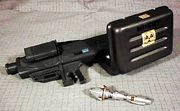
A BIF-5 with warhead and case
The Bragulan Infantry Fission missile is a micronuclear weapon with a variable yield ranging from sub-kiloton to double-digit kilotons. Standard BIFs are unguided dumbfire rockets similar to Space RPGs but with far deadlier warheads. Advanced models, such as the BIFG, used by better-equipped army units, special forces, and the Emerald Guard, have more sophisticated guidance systems to defeat modern defenses. In the Legion, BIFs are normally issued at the platoon level and conscripts only use them when authorized by their superiors, but favored professional volunteer and Shock units can be issued BIFs by squad. BIFs are used against ground vehicles, aircraft, and most often as bear-portable artillery support to indiscriminately level entire areas or as emergency weapons against Astartes or FORCE Marines. Commissars also favor the BIF to quickly deal with mass mutinies.
DD-214 Guang Incendiary Missile
The DD-214 Guang was developed in response to a requirement for the ability to set things on fire from a distance. Earlier iterations of the weapon utilized a triethylaluminum/triethylborane mixture, a strong pyrophoric (burns spontaneously in air) that was effective against most targets in a oxygen-based environment. However, the Lujun's leaders were unhappy, because the weapon was of limited effectiveness against targets in non-habitable atmospheres or hard vacuum; also, it was possible to fight the fire.
For the next iteration of the DD-214, the next brilliant idea was to load the missile with a oxidizer for the warhead instead of a fuel. The Lujun turned to the strongest liquid oxidizer it could find, called CPF. CPF is hypergolic with essentially every known solid substance, with no ignition delay measurable; materials it is known to react with include sand, stone, armor plate, and for that matter, Lujun researchers. Conventional methods of firefighting largely fail, as it will react with most firefighting agents, including water and carbon dioxide; smothering the fire also fails, as CPF is its own oxidizer and considers nearly everything to be fuel. Typical combustion products of CPF include a mix of some of the strongest acids known to man. The best methods of fighting a CPF fire are venting the atmosphere, or failing that, a good pair of running shoes.
DD-359 Zhen Quadrole Missile
The DD-359 Zhen quad-role missile comes in two variants: Slow and fast. Targets can include vehicles (including heavy armor), aircraft, bunkers, and personnel. The fast variant is more suited to attacking aircraft, while the slow model can fire over the horizon or over obstacles. The fast variant is a KE impactor with Cochrane generator, allowing exceptional velocity, while the slow variant substitutes a pinch warhead with directional capability. Both models are fired out of a sealed no-maintenance container. A standard MJ-95 sight module is utilized for aiming and targeting, usually the same one fitted onto the user's BQ-98.
F30A3 Hellstorm
A design by Pan-Empyrean Positronics' Experimental Warfare Division, the Hellstorm is a specialized anti-infantry weapons system that discharges a so-called "cargo" rocket. Each rocket is in fact a sensor system mounted atop a cluster of a dozen active-homing micro-missiles. These networked missiles are fitted with high explosive armor-piercing incendiary warheads and capable of coordinating their attack, jointly engaging one or more targets within a 2km radius. Ideal for city-clearing or operations in target-rich environments, the Hellstorm is the marines' preferred weapon when clearing out Karlack infestations.
M52 Rocket Launcher

An M52 rocket launcher
The M52 (formally Rocket Launcher, Caliber 102 mm, M52) is the standard anti-armor weapon issued to the SOS Imperial Guard and Marine Corps. Designed as a replacement for previous anti-armor weapons in SOS Imperial Armed Forces service, it represents a radical departure from previous designs. The M52 fires 102mm rockets from a pair of preloaded, disposable barrels that can quickly be detached from the launcher and replaced once both are exhausted. While the standard projectile is an unguided tandem-charge high explosive anti-armor rocket, the M52 is a highly versatile weapon capable of firing a variety of other munitions, such as high explosive dual-purpose, high explosive armor-piercing incendiary, tandem-charge anti-fortification, high explosive fragmentation, flechette, thermobaric, smoke, illumination, and EMP rockets; it can also be adapted to fire guided rockets, which allows it to be used as a fire-and-forget weapon. The launcher is fitted with an integrated targeting suite that includes optics, a laser designator, and battlefield networking gear. The launcher is built by Seburo, while the rockets are built by Anaheim Electronics and Kyoto Aerospace.
M83 SADAR
Designed by Solaris Advanced Weapons Corporation, the SADAR (Standard Active-Homing Direct Attack Rocket) is the premier anti-armor weapon available to a USMC light platoon. Alternatively shoulder-fired or fitted in box launchers, the SADAR is a fire-and-forget weapon designed to engage tanks, gunships and aircraft alike. It has a long range and a reasonable firing rate, especially considering the damage the weapon can inflict.
Originally fitted with a two-stage anti-fortification warhead, it soon became clear that even though the shaped-charge warhead design was effective against armor, Bragulan infantry could survive close proximity to a SADAR rocket detonation. SAWco therefore redesigned the rocket warhead to ensure maximum destruction of both hardened and soft targets. The new SADAR AMAG (Aerosol MAGnesum) penetrates heavy armor and discharges multiple megathermal payloads in its interior, delivering a high impact detonation that exposes the target to blast furnace temperatures high enough to flash-broil a Bragulan, thus ensuring a satisfactory degree of lethality.
SADAR launchers like most Solarian weapons can be remote-linked over a battle network through a Fire Control Unit. The FCU is an intelligent computer system which receives data from the local sensor matrix, including motion trackers, IR scanners, LIDAR, RADAR, robotic sentries or even visual feeds from helmet-mounted cameras. The FCU can be linked to command-wide units such as surveillance drones, forward observers, or satellites. It analyses all available sensor data and upon positively identifying a threat, it will lock on with one or more missiles and prepare to launch.
RL-87 Rocket Launcher
The RL-87 is the Centralite armed forces' primary anti-vehicle weapon, utilized to take down a wide range of vehicles from trucks to tanks and even low-flying aircraft.
Anti-Aircraft Weapons
FGM/FIM-262 Meteor Dual-Purpose Missile

An FGM/FIM-262 Meteor missile pod detached from its mounting
The FGM/FIM-262 Meteor is a dual-purpose guided missile manufactured by Anaheim Electronics and Kyoto Aerospace and used by the SOS Imperial Guard and Marine Corps. Several different launchers exist for the missile; the most common are a man-portable single-shot launcher and an eight-shot pod for use in fixed positions and on aircraft. The missile itself can be reconfigured with several different warheads, such as tandem-charge high explosive anti-armor, blast fragmentation (proximity or impact detonation), hypervelocity high explosive kinetic penetrator with delayed-fuse fragmentation, regular hypervelocity kinetic penetrator (trinium, tungsten carbide, or depleted uranium), and EMP.
ML-101 Anti-Air Missile Launcher
The ML-101 is a Centralite shoulder-launched man-portable air defense system designed to destroy enemy aircraft from rotorcraft to fast-movers.
YK6 Tactical Homing Ordnance, Radar-Guided (THOR) Missile
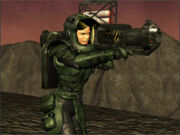
A mercenary with a THOR
Manufactured in the early 3350s by Schrom Corp for the United Solarian Marine Corps, the THOR is a fire-and-forget man-portable air defense system (MANPADS) composed of a launcher tube, targeters, and missile feed rack. Initially, the missiles had a simple sensor suite with an active electronic scanned array (AESA) radar and infrared search and track (IRST) system, but later upgrades included LIDAR and improved battle networking systems to better counter Bragulan nuclear jamming. Though it has been superceded by more modern weapons in USMC service, the THOR is still used by many planetary defense forces; it is also a popular export item that somehow always ends up in the hands of anti-Byzonist insurgencies. The THOR can launch a variety of warheads, such as standard high explosives, phased plasma pulse-producing detonators, EMP, nano-sharpened target-seeking proximity fragmenters, brilliant surface-to-air submunitions, and simple kinetic penetrators.
Melee Weapons
Atomic Broadsword
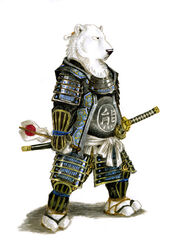
A bragshido warrior with an atom blade.
An ancient Bragulan weapon forged by swordmasters in the oriental planets of bragspace, the Atomic Broadsword is made out of nuclear fuel rods that are sharpened to a molecule and subjected to a secret folding technique to greatly strengthen the blade. The result is a very sharp, very radioactive weapon that glows with atomic energy. Such is its potency that its sheath is actually a cylinder containing exotic neutron inhibitors and coolants, and to safely wield the weapon, swordsbears must also don power armor lined with lead - or even gold, for truly great warriors - to block the radioactivity. Today, the art of crafting atomic swords is almost lost, only the true masters living in the most remote shrine worlds remember the ancient techniques. The swords made by counterfeiters are of poorer quality and prone to exploding.
True Atomic Broadswords are only in the possession of the Imperator, and those who he deems worthy of wielding the blade, or those who he consigns to take their own lives with honor. Ritualistic suicide by broadsword involves making the blade go critical and initiate. Lesser atomic swords are wielded by some ceremonial swordsbears, but only few truly know the warrior's way of the radioactive sword.
Beamsaber

A Lady of the Silver Moon with a beamsaber
- An elegant weapon from a more civilized age, not as clumsy or as random as a bolter.
The beamsaber consists of a physical handle containing a power source and focusing crystals which project an energy blade between 1 to 2 meters in length. The beamsaber can cut through most substances with ease, save for high-grade armors and extremely dense materials. It can cauterize flesh, deflect energy weapons, and block other beamsaber blades. This versatility has made it the favored weapon of many ESPer organizations, most notably the Order of the Silver Moon, whose members can wield beamsabers to maximum effect thanks to their gifts. Limited precognition enables wielders to deflect incoming energy weapon rounds, and intense training allows them to wield the weapon with unparalleled grace and mastery.
Byzantine Power Weapons
Byzantine power weapons come in various forms (swords, hammers, gauntlets, et cetera), but operate on the same principles. Each weapon contains a warp field generator that draws power from either a built-in rift or plasma power source or directly from the user if he/she is wearing a energy interface gauntlet. In the case of a power sword, the warp field generator produces a field around the monomolecular blade, thus enhancing its sharpness and gives it the power to cleave open the strongest inter-molecular bonds. In the case of a thunderhammer or a power fist, the hammer delivers a powerful warp field burst upon impact that shatters inter-molecular bonds utterly. These are among the most powerful melee weapons around and have proven themselves in combat repeatedly.
Combat Beating Stick
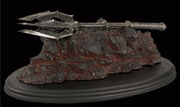
A combat beating stick
The officers of the Imperial Bragulan Commissariat are issued with beating sticks, but the extraordinary responsibilities entrusted to commissars in the military means that they must likewise wield extraordinary sticks to administer extraordimary beatings. The Combat Beating Stick is no mere simple bragsteel club; it is in fact a very sophisticated bragsteel club built to smash very sophisticated things.
The jagged stick-edges of Bragulan steel at the fore of the weapon can emit resonating nucleo-magnelectronic fields capable of smashing through armor, like the helmets of powered infantry. The settings are variable and the effects range from the explosive decapitation of unarmored heads to merely severe electrocution. The former setting is for close combat against the enemy, while the latter can be used for enforcing morale, performing interrogations, or administering defibrillations in first-aid medical stick-beating. Standard morale beatings on Bragulan subordinates are usually administered by inert beating-sticks to conserve their atomic batteries. Other features include (among others) a grappling hook launcher, an encrypted communicator, a voice amplifying macrophone, an iridium irradiator/illuminator, and a radio-frequency identificator with commissarial override. Beating sticks also contain surveillance devices to record all stick-beatings for posterity and evidence for Commissariat ideological reviews.
A secret use of the beating stick is that of an anti-memetic by administering conductive electroconvulsive shock therapy directly to Bragulan neural cortexes to override any harmful ideo-neurologic influences and reset proper Byzonic brain functions.
Dawkins/Tsien Militech ccw51 Surge Bayonet
On the surface, the ccw51 appears to be little more than a typical ceramic combat knife/bayonet with a 20cm blade, but there is more to this device than its outward appearance would indicate. The ccw51 has a built-in miniaturized shield generator system that activates when the blade is brought into sharp contact with something while it is held, as well as having a repulsion effect on similar weapons. In its default setting, the shield generator allows the blade to cut through most materials with relative ease; it can also be set to dump a considerable electric charge of around 250,000 volts into its target. These weapons are cheap and easy to produce and are standard issue to Commonwealth soldiers on the ground, as well as being sold abroad. Dawkins/Tsien Militech also manufactures a range of swords operating on this concept based around historical European and Oriental bladed weapons for export; a prototype sword for military purposes (the gladius-patterned ccw55) was also developed for the Commonwealth's military, although it was rejected due to weight concerns.
Klavostani Battleaxe

Charging Janissaries with Battleaxes
Even before Mankind left its twin cradles, melee weapons had become increasingly insignificant in an age of machineguns and worse. As Mankind took to both the stars and a dizzying variety of newer small-arms, it seemed like the age of the melee weapon was over. Still, in close confines of a starship being boarded, such weapons have their place... but the Orkish love of - and success with - their Choppa is 'just ridiculous', as many a shellshocked Klavostani veteran had reported long ago, when the latest small-arms and weight-of-fire tactics were alone simply insufficient to overcome a tidal wave of blood-mad Orks. The modern-day Janissary Power Armor provides an incredible strength-assist for the soldier inside, and when combined with the latest starship armor-grade unobtanium alloy battleaxe, it is the very most direct manifestation of the Sultanate's will and ability to meet the Ork head-on and counterattack.
M41 "Excalibolg" Combat Baton
Nicknamed after the weapon of the main character of a popular holovid series in the Holy Empire, the M41 baton is one of the few melee weapons issued on a regular basis to SOS Imperial Armed Forces soldiers. Designed seemingly as a response to the Bragulan combat beating stick, the Excalibolg operates on similar principles. Constructed from titanium alloy with an insulated handle, the Excalibolg's primary distinguishing features are its retractable tungsten carbide spikes, which can be deployed to improve its destructive capabilities against flesh and armor, and its variable-setting shock emitter, which can emit an electrical discharge of around 250,000-1,000,000 volts depending on setting.
Maibatsu Laserwhip

Slicing and dicing with a laserwhip
The laserwhip, also known as a lightwhip, is a weapon designed and used by assassins for the Maibatsu megacorporation. Not actually a laser weapon, the whip is a line of buckycarbon monowire along which a powerful electric charge is directed. Usually contained in a spindle of diamondoid or some other material capable of holding monowire without being cut, the laserwhip when activated is practically weightless, able to cut through almost any material cleanly and easily concealed, making it an ideal assassin's tool in close quarters. However, it is also extremely dangerous to its wielder; one wrong move might result in the would-be assassin cutting his own limbs off. For this reason Maibatsu operatives equipped with a laserwhip are fitted with implants and wetware to compute and control the movement of the whip during use.
Rainy Dayer
The Rainy Dayer is an Anglian speciality weapon developed by the good men and women of the ISS. It outwardly resembles a normal umbrella, but when the shaft is twisted and pulled in a special way, the user can draw the attached rapier blade out of the umbrella's shaft, and the umbrella itself is coated with a special fabric that offers limited protection against most handheld lasers and other energy weapons. The Rainy Dayer is typically fitted with a mono-edged blade, but Axelthorpe Weaponsmiths of Caledonia are known to manufacture a beamsaber version. As with all Axelthorpe weapons, however, these mastercrafted weapons are manufactured by hand, and though of exquisite quality are also excruciatingly expensive. A cane variant of the Rainy Dayer exists, and is rumored to be very popular amongst the Anglian diplomatic corps.
Umerian Spaceaxe
The Umerian spaceaxe is broadly analogous in many respects to the Klavostani battleaxe, but developed for different reasons and now (largely) out of use as a combat weapon. During the mid-to-late Chrome Golden Age, development of high-density power supplies caused personal ray-shielding technology to temporarily outrun personal energy weapon technology and material science. Personal shielding became the main line of defense for advanced body armor, and was easily capable of repelling fire from all but the heaviest semi-portable beam weapons and slugthrowers.
Until advances in weaponry caught up, use of a variety of low-velocity specialist weapons for fighting enemies in high-end shielded armor became a necessity in Umeria and its immediate surroundings. These ranged from refined and specialized devices like the hypertaser, thermic lance, and bomb-onna-stick to the crude, brutal, but surprisingly effective spaceaxe, a simple tool designed for use with the period's power armor.
One Golden Age writer, in one of his more overwrought moments, described the weapon as: "A dire weapon indeed, the space-axe. A combination of and sublimation of battle-axe, mace, bludgeon, and lumberman’s picaroon; thirty pounds of hard, tough, space-tempered alloy; a weapon of potentialities limited only by the physical strength and bodily agility of its wielder." More reusable than the bomb-onna-stick, cheaper than the hypertaser, and more versatile than the thermic lance, the spaceaxe also became popular among the Umerian Stellar Patrol as a demolition tool, for much the same reasons that fire axes remain in use among firefighters.
Improvements in other fields of technology made the spaceaxe largely obsolete as a primary combat weapon within a century or so, but its association with the height of the iconic Chrome Age gives it a symbolic role in Umerian culture, comparable with that of the sword in many other societies. Even today, there is a government-issue spaceaxe enhanced with dureum inlays and designed for Umerian power-armor units, classed as "Demolition Pry-bar, Heavy, Mk. XXVII." However, this is a specialist tool for assault units, carried at a level of one per squad or less, and is not used in serious combat under any but the most improbable conditions.
Dadao
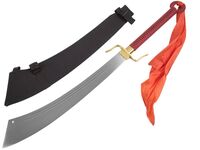
Dadao with scabbard
The Tianguo Dadao is definitely not elegant. Nor could the adjective finesse be applied to the wielder of one. Instead, they are brutal chopping weapons, with a blade perhaps 1 meter long, and a handle 60-100cm or so in length. They normally mass around 4 kilos. Made of advanced metal alloys, they have comparable strength to armor plate. They are, in fact, known for being able to chop clean through power armor. Assuming, of course, that the wielder is enhanced to be able to do so himself.
They have largely passed out of use, being one of several ceremonial weapons utilized by the Lujun. In the hands of a Goujia Moshushi, however, it can be a fearsome weapon indeed, as their magical enhancements allow them to avoid or shrug off rifle fire, and wield the sword with inhuman strength. They normally are handcrafted for their intended user, and so have significant variations in size, weight, and specific design.
Mines, Grenades, and Other Explosives
Blacksun Defense Technologies sdN20 Moray Rapid Deployment Mine
The sdN20 is a specialized area-denial mine utilized by the Commonwealth military. It is a cylindrical 7.5cm projectile fired from a variety of launchers, such as heavy belt-fed cannons, mortars, and handheld semi-disposable low-grade accelerators. It is mechanically set to be fired at comparitively low velocities. Once fired, the Moray does not explode on impact; instead, it either settles down where it lands or clings to walls by boring in and begins to sweep using its scanners. The mine casing is prefragmented with a number of penetrating flechettes. The Moray's integrated scanners sweep the surrounding environment for enemy soldiers; the scanners also include an IFF system capable of distinguishing between Nova Atlantean soldiers, hostile soldiers, and noncombatants. Once enemy soldiers are detected within its blast radius, it detonates; at close range, it is devastating against non-power-armored soldiers. Blacksun Defense Technologies has not exported the Moray to the general market.
Blacksun Defense Technologies TDH1 Tactical Deterrent Harness
A device specially created for the Unconventional Warfare Corps and later marketed to consumers well outside the Commonwealth's borders, the TDH1 series is a category of specialized defensive ordinance. Also known as the "MAD Vest," the TDH1, when inactive, resembles a bulletproof vest with a pair of compact speakers mounted on its back. The vest contains a set of highly redundant medical scanners, identification systems, and internal gauges and is layered with a set of visual textiles. When active, the TDH1 (if worn by its owner, which it is permanently keyed to) will display a highly noticeable and bright pattern and broadcast customizable slogans. Should the wearer be killed or the vest be removed while still active, the vest will detonate a set of explosive devices; if the vest is tampered with by someone other than the owner, the speakers will also broadcast a verbal warning stating the presence of armed explosives in order to deter would-be assassins from attempting to remove the vest. The standard loadout is a set of anti-personnel mines, although it can also accept a number of "unofficial" explosive payloads. The TDH1 is custom-made for each user, and a small number of devices are produced each year for both UWC personnel and non-Commonwealth customers. Officially, the device has only been used by UWC personnel a total of three times so far.
Despite its rarity, the TDH1 has appeared in a suprising amount of fiction over the years, both inside and out of the Commonwealth.
The Blue Bragcock

A dismantled Bragcock
Built by the Peoples's Ministry of Medium Machine Building of Bragule, the Blue Bragcock originated as a civilian atomic charge used for demolishing starscrapers and plowing bragricultural ditches; however, it was swiftly adopted by the Imperial Legion Corps of Engineers and later circulated to other services. The modern Bragcock is a compact device, barely 50 kilograms in weight and roughly the size of a small fridge. It sports sensitive seismographs to detect enemy troop movements and a microcomputer to determine the optimum time of initiation. It uses a similar warhead to the BIF-5 and can be salted with vegemite derivatives or Cobalt Thorium G to increase fallout.
Bragulan Stick Grenades
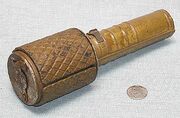
Standard Bragstick grenade
Standard Bragulan grenades come in many varieties. The most common is the simple brag frag, an enhanced explosive wrapped in a bragsteel casing that fragments into monomolecular-edged shrapnel to perforate the weak spots of modern power suits or utterly masticate lighter armor. Another bragtime favorite is the K-grenade, which blasts molecular acid for dozens of meters, outright melting those in its radius or weakening armor enough for a follow-up brag frag attack to work its magic. Thermobarics are standard fare for Bragulan counter-terrorists and hostage rescues, along with caustic nerve agents. Radiological grenades use fission byproducts and are exceptionally dirty bombs. Plasma grenades use harvested Karlack bioplasma and vespene to create a highly adhesive superheated substance that sticks like superglue and burns hotter than the surface of a sun. Many grenades are non-metallic (some are even made out of lumber) and can be used as hard-to-detect mines or braggy-traps. The stick shape of Brag grenades also means they can be used as makeshift clubs.
C4
An old favorite that is still used by many nations despite the existence of newer types of explosives.
M27 Jiang Shi Anti-Personnel Mine
The M27 Jiang Shi is a bounding anti-personnel mine fielded by the SOS Imperial Guard and Marine Corps. A modern descendant of the ancient "Bouncing Betty" once used on Old Earth and Nova Terra, the M27 is little changed from its ancestor in terms of general concept. In its basic form, the M27 consists of a small composite cylinder with the triggering mechanism mounted on top. While the mine is normally triggered by a pressure fuse, it can be modified to be triggered via tripwire or remote detonator; the standard pressure fuse is designed to activate if depressed by a weight of roughly 7 kilograms or greater. Internally, the main charge is surrounded by 360 depleted uranium balls or tungsten carbide rods, depending on the mine's construction; the mine can also be wrapped in a metal casing that fragments upon detonation, improving its effectiveness but making it more prone to detection.
When activated, the M27 Jiang Shi fires itself roughly 1-1.5m into the air with a small propellant charge before detonating, spraying shrapnel at high velocities. The main fuse of the mine is designed to trigger the propellant charge 4 seconds after initial triggering. The M27 is guaranteed lethal within 20m and can reliably cause injuries within 100m; SOS Imperial Armed Forces training manuals note that the mine can cause casualties as far as 140m. In practice, the M27 is often planted alongside an armed fragmentation grenade, with the mine resting against the grenade's safety lever; if the mine is triggered or if an enemy attempts to disarm the mine, the grenade goes off, inflicting additional casualties.
M29 Nodachi Anti-Personnel Mine
The M29 Nodachi is a directional anti-personnel mine fielded by the SOS Imperial Guard and Marine Corps. A modern descendant of the ancient M18 Claymore once used on Old Earth and Nova Terra, the M29 is little changed from its ancestor in terms of appearance and general concept. The weapon consists of a horizontally convex composite case with an open sight for aiming, two pairs of scissor legs to support the mine and allow it to stand up, and fuse wells set at 45° on both sides of the sight; the front surface of the case has the words "FRONT TOWARDS ENEMY" embossed on it in both English and Japanese. Internally, the mine consists of a layer of explosive behind a matrix of approximately seven hundred 4mm depleted uranium balls set into an epoxy resin. When detonated, the mine disperses the balls at extremely high velocity into a 60° fan-shaped pattern that is 2m high and 50m wide at the mine's optimal effective range of 50m; however, the DU fragments are still effective as far as 250m. While primarily an anti-personnel weapon, the M29 can also be used against unarmored and lightly armored vehicles.
The M29 Nodachi can be detonated by any mechanism that sets off the blasting cap. Controlled detonation can be accomplished with either a command wire or radio control firing device; physically wiring several mines together or keying their receivers to accept a single signal can allow several mines to be detonated simultaneously. Tripwires and timers can also be used.
M167 Standard Grenade
The M167 standard grenade is, as the name suggests, the common grenade used by the USMC. It has a candle-shape "cargo" body that can be loaded with a stunning variety of different warloads. The M167 is digitally fused and has three modes: Contact, time, and proximity. These are chosen through a simple interface on the top of the grenade, but for full access to the M167's versatilty and functionality, a battlesuit interface is required. The default mode hardwired into the fuse is the time delayed mode.
In contact/time mode, the weapon will go off upon landing or after a set time delay (set at 5 seconds from release, but alterable to up to 24 hours or instant for booby traps). An activated M167 is set to detonate after 24 hours if not triggered to lessen the problem of fratricide and clearing of unexploded ordnance.
The proximity mode waits a pre-set time (generally a minute) after the "pin" is pulled and then waits until a target approaches. The trigger setting is variable, and this mode is frequently used during retreats: A grenade on proximity is flung into the trench the soldiers are abandoning in order to kill the first enemy to enter it. It is also common in urban operations as a quickly set-up booby trap. The proximity mode also has an IFF receiver which will prevent detonation of the grenade should the correct code be transmitted to it.
M167 variants currently in use by the Marine Corps are:
- HE: The most common variant, a HE frag grenade with a 15m primary burst radius.
- HE Target Seeking: A modernized version of the standard HE, the HETS variant developed by Maibatsu is fitted with a set of microthrusters and a rudimentary motion seeker, allowing it limited independent targeting whilst airborne. Commonly used in urban combat situations.
- Enhanced HE: This grenade foregoes the standard explosive charge in favor of a specially stablized QCW-derived ceramic enhanced explosive. Upon detonation, the grenade has a 25m primary burst radius and causes a shockwave of displaced air that is dangerous to unarmored humans up to 35m. It is therefore unadvisable to use this grenade type without either power-assisted throwing or some form of protective armor.
- HE Breaching: Fitted with an area explosive designed to increase penetration at close range but lose speed rapidly, breaching grenades are usually used as door openers or removers, as they will blow a 2m hole in light surfaces.
- HEAT: Directed-charge "smart" grenade used against combat armored troops and light armored vehicles. A sensor mated to an atomic gyroscope inside the grenade directs it toward the target and judges optimal distance before detonating, creating a very high-velocity stream of metal in a state of superplasticity powerful enough to breach most light combat armors.
- High Explosive Flechette: Another Maibatsu special designed for use against soft targets, HEF grenades discharge a tight cluster of 12 flechettes made of a brittle ceramic with an explosive core. The flechettes avoid over-penetrating by exploding inside their targets.
- Close Combat Flechette: CCF grenades pepper a target with a pre-programmable burst of flechettes that, thanks to memory plastics, upon penetration expand and compress to roughty the shape and size of a quarter, dealing terrible damage to organic targets. Because CCF grenades cannot penetrate standard USMC battle-armors they are favored for close combat situations.
- Stun: A less-lethal grenade type designed to temporarily neutralize the combat effectiveness of enemies by overloading their senses. Generates a bright flash of light and an extremely loud blast.
- Tangler Monowire: Contains a spooler of buckycarbon monowire that is very thin, very strong, very sharp, and nearly impossible to spot with the unaugmented eye. Upon detonation, the grenade will disperse threads of monowire across a 20m area. Against unprotected targets unfortunate enough to walk into it, the monowire will penetrate quickly and deeply, causing serious injury.
- EMP: Creates a burst of intense electromagnetic radiation that will damage any unprotected electronics caught in its area of effect.
- AMAG: Canister containing an aerosol magnesium incendiary payload. AMAG grenades produce heat intense enough to burn through almost anything. Because the substance carries its own oxidizer, it will burn almost anywhere too, even in the vacuum of space.
- Prism Smoke: Disperses a dense tailored smoke agent that inhibits infra-red, motion tracking, and some lasers.
- Biotech Motion Restraint: Another less-lethal type, BMR grenades disperse a foam-like substance that quickly hardens into a semisolid muck nearly impossible to escape from without power-assisted movement.
- Scrambler: Highly specialized grenade type that produces a brief flash of visible light and a complex burst of radio- and hyperwave signals on most commonly used frequencies. The Scrambler grenade fills these frequencies with a militarized cognomemetic message that, in unprepared targets, induces a mix of inconsistent beliefs and mistaken perceptions that cause the cerebral cortext to shut down.
- Programmable Nanostat Swarm: Usable only with a battlesuit interface, the PNS grenade disperses a payload of grey goo to a target area. These multi-purpose nanites can then perform a variety of functions, from assassination of unfriendly targets to the construction of a short-range surveillance network.
- Gauss Field: Creates a brief burst of intense gravitomagnetic distortion that will disrupt anti-gravity fields and magnetically attract metallic objects.
Type 1102 Plas-Frag Grenade
The Type 1102 is a plasma fragmentation grenade used by Centralite infantry.
Non/Less-Lethal Weapons
Blacksun Defense Technologies MA-50 Triceratops Non-Lethal Infantry Weapon
The MA-50 Triceratops is a multi-purpose non-lethal weapon. Due to fairly restrictive personal firearms laws within the Nova Atlantean Commonwealth, there is a thriving market for effective non-lethal weaponry. Colloquially referred to as "Sarah," the MA-50 is is configured like a typical assault rifle and sports three different weapons systems. The first weapon fires a calibrated electro-particle beam specially designed to overload the target's nervous system, typically rendering the target unconscious; the electro-particle beam has an effective range of 500 meters. The second weapon is a sonic pulser that unleashes a blast of intense ultrasonic sound, much like a Solarian sonic-electronic ball-breaker; while the sonic pulser has a lower effective range than the stun beam (about 50 meters), it can affect multiple targets due to its conical area of effect. The third weapon is a 20mm low-velocity launcher with a 8-round magazine designed to deploy DollDust(TM) canisters and other non-lethal ordinance, including various types of airborne and contact riot control and incapacitating agents.
The MA-50 is generally well-regarded for its flexibility and utility and is another popular item on the export market, though it does face competition from various other weapons systems, such as the Cobra pistol. As is typical for Nova Atlantean infantry weapons, it can be outfitted with a variety of anti-theft devices (both passive and active), with the active ones designed specifically to incapacitate. Blacksun also markets two sidearm-sized weapons based around the electro-particle beam (designated the MA-51 Wasp) and sonic pulser (the MA-52 Bison).
Brown Gun

A cadet drills with a Brown Gun in Police Academy
The Brown Gun is a non-lethal acoustic weapon that does not incapacitate through conventional sub-aural methods (like in sonic-electronic ball breakers). It emits focused low-frequency sound, Brown Noise, that stimulates the human pyloric sphincter, causing those unfortunate enough to be in the affected area to develop severe bowel movements resulting in an unsightly and undignified... mess. The Brown Gun has become rather notorious with criminals, and the mere sight and smell of it is enough to cause many sense-offenders to surrender. There have been occasions where the felons, and even the rescued hostages, have sued police for the undignified use of Brown Guns.
Brown Guns are meant to be used by police to incapacitate and/or disorient hostiles in situations like riots, hostage takings, and prolonged sieges. Specialized soundproofed vehicles can mount large Brown Guns because the riot control variants are designed to affect wide areas and large groups, not just individuals. Hand-held Brown Guns are used on individuals and small groups to demonstrate that civil disobedience is still disobedience.
It is customary for the police to bring sanitation specialists whenever Brown Guns are employed. The most memorable use of the Brown Gun was during the underhive riots of the Solarian Mega Cities during 3393, when the Meg used the device on thousands of unruly demonstrators and protesters. The resultant crowd-dispersal left such a mess that it took city sanitation services several days to clear and a whole week to deodorize.
Control Gun
The Control Gun is a pistol-sized weapon used by CSB and Party Overseers that utilizes an EM field that disrupts the target's higher mental functions, leaving the victim incapable of resisting any order.
Pain Ray
Union pain rays are used in a variety of nonlethal applications from police pursuit to battlefield suppression. MADNESS Planetary Systems was largely responsible for their development as a means of area denial against light infantry. The Expeditionary Planetary Forces make liberal use of high-power variants, frequently mounting them on armoured vehicles.
The pain ray is used extensively by Civil Protection Forces to nonlethally pacify fleeing and/or threatening individuals. Modern examples are fitted with systems to record when, where, and for how long the pain ray was activated (up to and including the orientation of the device during its use), and transmit this data back to local oversight units, in realtime, for immediate review. These systems can be removed through tampering, but due to obvious potential abuses, the possession of an 'unchained' pain ray is highly illegal and carries extreme penalties.
Pfhor Shock Weapons
The most famous of Pfhor technologies is the shock weapon, so named because one of their effects is the inducing of incredible pain in any biological entity that they strike through a vaguely electrical effect that stimulates pain receptors and the regions of the brain responsible for processing pain. The electrical effect is also heavily disruptive to electronics, creating a similar disabling effect in unshielded robotics.
The electric effect has been described by those unfortunate enough to be attacked by a shock weapon to progress in several stages:
- The first is intense pain at the point of contact with the shock "bolt," in the case of a projectile shock weapon, or a shock "field" otherwise. This sensation has been compared to that of a white-hot iron, or highly caustic acid.
- The above stage seems to last for several moments to the victim, the pain often described as "hanging" at the contact point, before proceeding to the next stage. In reality, this transition occurs almost instantaneously, but something about the effect seems to vastly slow down the target's perception of time at this stage.
- The pain then instantly "shoots" throughout the victim's entire body, as the electric effect simulates all of the target's pain receptors and the regions of the brain responsible for processing pain. Occasionally, this stage triggers involuntary muscle spasms and, curiously enough, "blinking" visual/auditory hallucinations in the victim. Any hallucinations triggered are almost always incredibly unpleasant for the victim.
- The intense pain caused by this second stage generally lasts for thirty seconds to a minute, if the shock weapon was set to kill. Setting the shock weapon to stun results in the pain lasting much longer. Any hallucinations triggered generally only last for roughly ten to fifteen seconds, regardless of the setting of the weapon.
- After the intense pain recedes, the victim feels a duller pain in a large region around the contact point, describes as a hot "throbbing" or "simmering" sensation. Moving the affected area induces sharp shooting pains in both the affected area and the brain, and if the region struck is a limb, it is generally unusable for the duration of this stage, one to three hours regardless of the setting of the weapon.
- After the third stage ends, the victim feels aches and pains throughout his body, most intense at the point of contact. This stage, however, is unique in that it can be treated with conventional painkillers, which the previous three stages cannot. This stage generally lasts from one to three days, depending on the individual, and repeated exposure to the shock effect most dramatically reduces the duration and intensity of this stage.
While conventional painkillers and anesthetics are ineffective against the shock effect, there exist specialized and fairly inexpensive drugs that will negate the shock effect completely if administered prior to exposure and quickly negate the pain caused by the shock effect if administered after exposure. Any personnel expecting to enter combat with shock-armed opponents are highly advised to bring and use these drugs. The protection offered by a single dose of these drugs typically lasts around half an hour, depending on the manufacturer and individual.
The shock effect, while electrical in nature, does not travel through known electrical conductors, only live or recently-live biological tissues. If a shock bolt does not penetrate any armor worn by a target, the shock effect will simply not be felt.
In addition to the shock effect, ranged shock weapons set to kill also have substantial kinetic and slight thermal effects on their targets, making them capable of damage even if the shock effect is negated. If the shock effect is negated, they are generally slightly less effective than the average galactic weapon of a similar class.
Shock weapons form the mainstay of the Pfhor military's small arms, being produced in sizes and classes ranging from small pistols and batons all the way to heavy machine-guns, at which point the technology begins to scale very badly. Large numbers of shock weapons have also found their way onto the wider galactic arms market.
RN/L-2 Crowd Control Rifle

A Federal Army soldier in full armor cradles a FN/L-2 during a riot
The RN/L-2, more commonly known by the slang terms of "heat ray" and "microwave gun," is a crowd control weapon manufactured primarily in the Humanist Union for use by police and military units in crowd control situations. The RN/L-2 is a nonlethal weapon that utilizes an intense beam of electromagnetic radiation to disrupt and debilitate targets through pain without leaving any long-lasting injury or disfigurement. The RN/L-2 is used sparingly whenever possible, typically only when protests turn violent. While compact in size, the RN/L-2 is a fairly hefty tool. Its rugged construction makes it unintentionally useful as a cudgel in melee situations, and critics of the Humanist Union have been known to claim that one is just as likely to be hit in the face with an RN/L-2 as to be shot with one. The RN/L-2 is occasionally utilized as a torture device, though the Humanist Union does not officially consider the weapon useful in the capacity of an interrogative tool and punishes abuse of the weapon quite severely.
Sonic Shotgun

MaxTac Sonic Shotgun
After the dismal failure of the Brown Gun during the 3393 civil unrest, MaxTac ditched its contract with SchromKorp in favour of a more practical weapon developed by Pan-Empyrean Positronics. The Sonic Shotgun (officially the Sonic Concussion Rifle) looks roughly like a sawed-off shotgun but discharges concussive waves of sound with enough force to knock targets down in close quarters. A secondary mode produces ultrasonic pulses that cause extreme, incapacitating inconvenience in the form of the equivalent of an instant migraine. Although use of the Sonic Shotgun, especially in its primary "blasting mode," has a greater risk of causing bodily harm than the now-obsolete Brown Gun, it has been universally adopted by Solarian law enforcement as a replacement, mainly because of widespread complaints by city sanitation services.
Zigonian Cobra Pistol
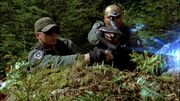
Two Replicants firing Cobra pistols
Manufactured by Zhaoermia-i-Gallimimus (ZiG), the Cobra pistol (called such due to its serpentine form) is a smart-aiming neuro-neutralizer. Its targeter tracks nervous system functions, allowing it to discriminate susceptible biological targets from incapacitated victims or inanimate objects. It fires a coherent beam that temporarily scrambles the somatic nervous system while debilitating higher brain functions. The effect is extremely painful and disabling, and the sophisticated targeting system ensures that a target is only hit once with a bio-calibrated pulse. Repeated hits can be lethal, inducing cardiac arrest or even permanent brain death. The Cobra pistol is one of the few less-lethal weapons that is as effective against cyborgs as it is against organics. Its primary competitors on the galactic arms market are the Nova Atlantean MA-50 Triceratops and the Pfhor's wide variety of shock weapons.
A version for the Nova Atlantean market was jointly developed with Dawkins/Tsien Militech. This Cobra features a three-tier firing system when fired in rapid succession against the same target; the first shot stuns, the second is lethal, and the third is even more permanently fatal. It also has a single-mode "active" anti-theft system; when wielded by an unauthorized user, the weapon's aperture turns and discharges once (often directly in the user's face) before a built-in communicator alerts a medical response team. This modified Cobra was ultimately rejected in the Commonwealth, ostensibly due to numerous "safety concerns"; these concerns were questioned, as the modified Cobra's anti-theft system was hardly any different from the popular thousands-volt electrocution systems of other Nova Atlantean weapons like the VX-23 Deathcaster, and ZiG suspected that the rejection was more due to Nova Atlantean trade protectionism than legitimate consumer safety issues. ZiG later adapted some of the modified Cobra's features (except for the anti-theft system) in a more refined form for other variants.